
カタログの抜粋

Syntron® Working with Isolation
カタログの1ページ目を開く
Syntron® Working with Isolation Purpose . . . . . . . . . . . . . . . . . . . . . . . . . . . . . . . . . . . . . . . . . . . . . . . . . . . . . . . . . . . . . . . . . . . . . . . . . 4 Base Mounting . . . . . . . . . . . . . . . . . . . . . . . . . . . . . . . . . . . . . . . . . . . . . . . . . . . . . . . . . . . . . . . . . 5 Base Mounting Views . . . . . . . . . . . . . . . . . . . . . . . . . . . . . . . . . . . . . . . . . . . . . . . . . . . . . . . . . . 6 Snubbers and Tag Lines . . . . . . . . . . . . . . . . . . . . . . . . . . . . . . . . . . . . . . . . . . . . . . . . . . ....
カタログの2ページ目を開く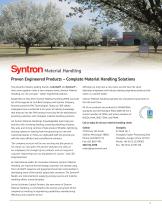
Proven Engineered Products – Complete Material Handling Solutions Two powerful industry leading brands—Link-Belt® and Syntron®— have come together under a new company name, Syntron Material Handling, LLC, for one goal – better engineered products. Although we may have a new name, we still have the same dedicated employees and industry leading engineered products that make us a market leader. Established in May 2014, Syntron Material Handling (SMH) was built out of the legacies of Link-Belt Company and Syntron Company, formerly owned by FMC Technologies. Today, our 300 skilled employees have...
カタログの3ページ目を開く
Purpose This book is provided by Syntron Material Handling as an aid to answer common questions relating to vibratory equipment isolation. Proper wire rope and various hardware items will be reviewed to ensure the installation will allow the vibratory equipment to perform properly. The purpose of this book is to discuss the recommended methods for installing vibratory equipment isolation systems. It will address both suspension and base mounting along with the installation of safety cables. Since most vibratory equipment is suspension mounted, it will be the primary focus. In addition, the...
カタログの4ページ目を開く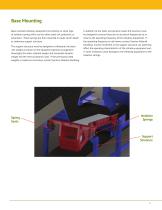
Base Mounting Base mounted vibratory equipment sits directly on some type of isolation spring, which can be either steel coil, polymeric, or pneumatic. These springs are then mounted on seats which attach to stationary support structure. The support structure must be designed to withstand: the static unit weight as shown on the equipment general arrangement drawing(s), the static material weight, the horizontal dynamic weight and the vertical dynamic load. If the previously listed weights or loads are not known, contact Syntron Material Handling. Spring Seats In addition to the static and...
カタログの5ページ目を開く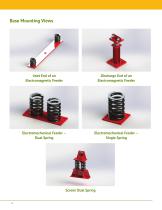
Base Mounting Views Inlet End of an Electromagnetic Feeder Discharge End of an Electromagnetic Feeder Electromechanical Feeder – Dual Spring Electromechanical Feeder – Single Spring Screen Dual Spring 6
カタログの6ページ目を開く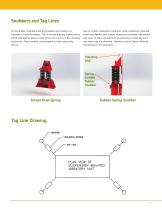
Snubbers and Tag Lines On some base mounted brute force feeders and screens it is necessary to install snubbers. This is usually a spring-loaded device which rubs against pads on each of the four corners of the vibrating equipment. These snubbers are designed to help reduce side motion. Due to certain installation conditions, some suspension mounted brute force feeders and screens experience unwanted side motion and sway. In these situations, it is customary to install tag lines (see below tag line drawing). However, consult Syntron Material Handling prior to installation. Vibrating Unit...
カタログの7ページ目を開く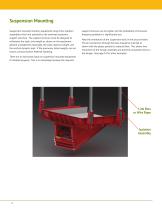
Suspension Mounting Suspension mounted vibratory equipment hangs from isolation assemblies which are attached to the overhead stationary support structure. The support structure must be designed to withstand: the static unit weight as shown on the equipment general arrangement drawing(s), the static material weight, and the vertical dynamic load. If the previously listed weights are not known, contact Syntron Material Handling. support structure can be lighter and the probability of structural frequency problems is significantly less. Note the orientation of the suspension bails in the...
カタログの8ページ目を開く
Suspension Hanger Views Electromagnetic Angle Hanger Electromagnetic Bail Hanger Electromagnetic Inlet Beam Hanger 9
カタログの9ページ目を開く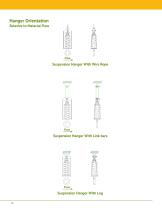
Hanger Orientation Relative to Material Flow Suspension Hanger With Wire Rope Suspension Hanger With Link-bars Suspension Hanger With Lug
カタログの10ページ目を開く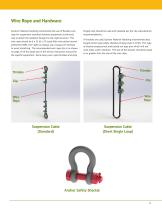
Wire Rope and Hardware Syntron Material Handling recommends the use of flexible wire rope for suspension mounted vibratory equipment as the best way to attach the isolation hangers to the rigid structure. The wire rope should be 6 x 25 (6 x 19 class) filler wire yellow strand preformed IWRC core right lay regular lay or equal pre-stressed to avoid stretching. The recommended wire rope size is as shown on page 19 of this book and in the service instruction manual for the specific equipment. Extra heavy wire rope thimbles and drop forged clips should be used and installed per the clip...
カタログの11ページ目を開く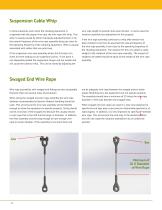
Suspension Cable Whip In some situations, even when the vibrating equipment is suspended with the proper wire rope, the wire rope will whip. This whip is usually caused by either improperly adjusted tension or by the natural frequency of the wire rope assembly being too close to the operating frequency of the vibrating equipment. Whip is usually associated with cables that are quite long. If the suspension wire rope assembly whips, the first step is to check for even loading on all suspension points. If one point is not adequately loaded the suspension hanger will not isolate and will cause...
カタログの12ページ目を開く
Turnbuckles and Rods Syntron Material Handling does not recommend the use of turnbuckles or rods. Turnbuckles are generally used to make initial installation of equipment easier or to make slope adjustments to the vibratory equipment. However, the potential problems may far outweigh any perceived benefits. capacity should be achieved through the use of a variable control. If it is easy to adjust, it is easy for the unit to accidentally contact the stationary structure and damage will result. Furthermore, after initial installation the turnbuckles should be pinned and locked. This will make...
カタログの13ページ目を開く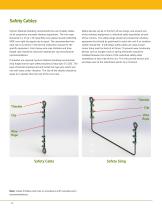
Safety Cables Syntron Material Handling recommends the use of safety cables on all suspension mounted vibratory equipment. The wire rope should be 6 x 25 (6 x 19 class) filler wire yellow strand preformed IWRC core right lay regular lay or equal. The recommended wire rope size is as shown in the service instruction manual for the specific equipment. Extra heavy wire rope thimbles and drop forged clips should be used and installed per clip manufacturer recommendations. If shackles are required, Syntron Material Handling recommends drop forged anchor type safety shackles (Crosby style...
カタログの14ページ目を開くSyntron Material Handlingのすべてのカタログと技術パンフレット
-
Bin Vibrator Catalog
30 ページ
-
Paper Joggers Catalog
20 ページ
-
Material Handling
2 ページ
-
Vibrator Flowaids
30 ページ
-
Syntron Vibrators
48 ページ
-
Belt Conveyor Idler
160 ページ
-
Syntron Jogger
20 ページ
-
CEMA Series E4000 Idlers
36 ページ
-
CEMA Series C2000 Idlers
22 ページ
-
CEMA Series B2000 Idlers
22 ページ
-
Ball Bearing Idlers
8 ページ
-
Aggregates
20 ページ
-
Coal Handling
20 ページ
-
Syntro-Flo
2 ページ
-
Working with Hoppers
28 ページ
-
C2000
2 ページ
-
Link-Belt Screw Conveyor
101 ページ
-
Link-Belt Underground
32 ページ
-
Link-Belt Idler
160 ページ
-
Syntron® Vibrators
48 ページ
カタログアーカイブ
-
PowerPulse WT
2 ページ
-
HV-10
2 ページ








































































